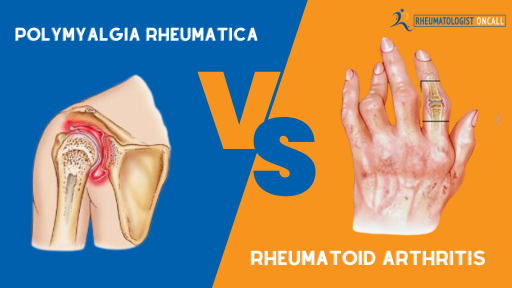SHARE
If you’ve noticed increasing joint pain and stiffness, you may be wondering what’s causing your symptoms. Two common culprits are Polymyalgia Rheumatica (PMR) and Rheumatoid Arthritis (RA). While these inflammatory arthritis conditions share some similar features, key distinctions exist.
Defining Characteristics of PMR and RA
PMR involves severe shoulder and hip pain, while RA most commonly begins in smaller joints like wrists and fingers before potentially spreading. But early on, the joint pain itself can seem comparable between the two conditions. Understanding how to tell them apart is critical for accurate diagnosis and management.
Location of Joint Pain Differs Between Diseases
Polymyalgia Rheumatica (PMR) vs Rheumatoid Arthritis pain location differs. PMR patients experience profound stiffness and achiness centered in large joints like shoulders, neck and hips. The pain may have a rapid or overnight onset, often described as coming out of the blue. RA joint involvement starts more gradually, classically in matching joints on both sides of the body – hands, wrists or feet.
PMR Stiffness is More Pronounced
While both PMR and RA cause morning joint stiffness, it tends to last longer with PMR – sometimes taking hours to improve after waking. RA stiffness may linger up to an hour after getting out of bed before slowly easing up.
Age of Onset Varies
Polymyalgia rheumatica vs rheumatoid arthritis also differs in age of onset. PMR occurs almost exclusively in adults over age 50, more commonly impacting those in their 70s. RA can begin at any adult age, but most typically develops between ages 30-50 years old.
How to Distinguish PMR from RA

Determining whether shoulder and hip pain stems from RA or PMR can be complex. Doctors utilize several strategies to tell these conditions apart:
Bloodwork Analysis
Inflammatory markers like sedimentation rate (ESR) and C-reactive protein (CRP) are elevated in both PMR and RA. However, Rheumatoid Factor (RF) and anti-CCP antibodies provide evidence to support an RA diagnosis specifically. These key blood tests help differentiate between diseases.
Pattern Evaluation
The symmetry of joint involvement provides useful clues. PMR may bounce around from one shoulder to the next, while RA systematically impacts the same joints on both sides of the body – both wrists, several knuckles, etc.
Disease Course Monitoring
Untreated PMR symptoms may continue for weeks to months but eventually subside entirely on their own, though likely to recurrence. RA is marked by chronic inflammation and incremental joint damage without medications to control the immune system attack on joints.
Response to Treatment
While both conditions involve immune dysfunction, specific therapies used for RA and PMR differ significantly. Fast and dramatic improvement with low-dose oral corticosteroids points to PMR. RA requires other non-steroidal medications for disease modification and prevention of disability.
Takeaway for Patients with Persistent Pain
For those over 50 with worsening shoulder discomfort and stiffness that just won’t quit, PMR may be the culprit. Request an evaluation with a rheumatologist to determine the cause and craft an appropriate treatment plan matched to your diagnosis. Living with uncontrolled inflammation is unnecessary – relief is within reach.
If you’re looking for compassionate care and rheumatology expertise, RheumatologistOnCall offers telemedicine visits with experienced specialists across most US states. You may conveniently book your consultation online today! We’re here to help unravel the mystery behind your joint pain.














